Unit - 1
Compass and Levelling
Surveying is the art of determining the relative positions of different objects on the surface of the earth.
Importance of Surveying:
a) to repair the countrywide and kingdom boundaries;
b) to chart coastlines, navigable streams and lakes;
c) to set up manage factors;
d) to execute hydrographic and oceanographic charting and mapping; and
e) to put together topographic map of land floor of the earth.
Key Takeaways:
1) Surveying is the art of determining the relative positions of different objects on the surface of the earth.
There are two aspects:
1. Location of a point by measurement from two points of reference
a) According to this principle, the relative position of a point to be surveyed should be located by measurement from at least two points of reference, the positions of which have already been fixed.
2. Work from whole to part:
1) According to this principle, it's far constantly suitable to carryout survey paintings from entire to part. This means, whilst a place is to be surveyed, first a device of manipulate factors is to be mounted overlaying the entire location with very excessive precision. Then minor information is placed with the aid of using much fewer particular methods. The concept of running this manner is to save you the buildup of mistakes and to manipulate and localize minor mistakes which, otherwise, could increase to more magnitudes if the opposite method is followed, for this reason making the paintings out of control on the end.
Key Takeaways:
1) There are two aspects:
a. Location of a point by measurement from two points of reference
b. Work from whole to part:
Surveying:
1) It is the art of determining the relative positions of different objects on the surface of the earth.
Object of Surveying:
There are two types of surveying:
Plane Surveying:
Geodetic surveying:
Key Takeaways:
1) There are two types of surveying:
a) Plane Surveying
b) Geodetic surveying
The ratio by which actual length of the object is reduced or increased is known as scale.
Types of scale:
1. Full size scale:
If the actual length of the object is shown on the drawing.
2. Reducing scale:
If the actual length of the object is reduced in order to accommodate it on the drawing sheet the scale is said to be a reducing scale.
3. Increasing or Enlarging scale:
If the actual length of an object is enlarged so as to bring out its details more clearly on the drawing, the scale used is said to be increasing scale.
Key Takeaways:
1) There are three types of scale:
a) Full size scale.
b) Reducing scale.
c) Increasing or Enlarging scale.
The process of establishing intermediate points on a straight line between two end points is known as ranging. It is done before a survey line is chained. It consists of two methods:
1) Direct method: when intermediate rainging rods are fixed on a straight line by direct observation from end stations, the process is known as direct ranging
2) Indirect ranging method: when the end station is not intervisible due to being high ground between them, intermediate ranging rods are fixed on the line in an indirect way this method is known as indirect ranging.
Key Takeaways:
1) The process of establishing intermediate points on a straight line between two end points is known as ranging.
A chain is prepared with 100 or 150 pieces of galvanised mild steel wire of 4mm, the end of the pieces are bent to form loop and then the pieces are connected to get with the help of 3 oval rings. Which make the chain flexible. Two brass handles are provided at the two ends of the chain. Tallies are provided at every 10 or 25 links.
Metric chain:
Metric chains are available in lengths of 20m and 30m. The 20m chain is divided into 100 links, each of 0.2m. Tallies are provided at every 10 links (2m). This chain is suitable for measuring distances along fairly level ground.
Steel Band:
It consists of a ribbon of steel of width 16mm and of length 20 or 30m. It has a brass handle at each end. It is graduated in meters, decameters, and centimeters on one side and has 0.2m links on the other. The steel band is used in projects where more accuracy is required.
Engineer's chain:
The engineer's chain is 100 ft long and is divided into 100 links. So, each link is of l ft. Tallies are provided at every 10 links (10 ft), the central tally being round. Such chains were previously used for all engineering work.
Gunter's chain:
It is 66 ft long and divided into 100 links. So, each link is of 0.66. It was previously used for measuring distances in miles and furlongs.
Revenue chain:
The revenue chain is 33 ft long and divided into 16 links. It is mainly used in cadastral survey.
Key Takeaways:
1) There are five types of chain:
a) Metric chain,
b) Steel Band,
c) Engineer's chain,
d) Gunter's chain,
e) and Revenue chain.
1) The lateral measurement taken from the object to the chain line is called offset.
2) There are two types of offsets:
a) Perpendicular offset,
b) Oblique offset.
A traverse is a series of connected lines whose lengths and directions are to be measured and the process of surveying to find such measurements is known as traversing.
1) Prismatic compass is used for angular measurements of angles between two or more relative points in horizontal plane.
2) The prismatic compass is a portable form of magnetic compass which is installed on a tripod stand by which angles are measured in horizontal plane.
3) The main parts of the prismatic compass are shown below:
1. Pivot:
Pivot is made of hard steel material. It is fixed at the centre and on which magnetic needle with graduated circle can be balanced.
2. Lifting lever:
To prevent undue wear, the needle when not in use should be lifted off the pivot by means of lifting lever.
3. Brake pin:
When brake pin or knob pressed gently, it touches the edge of the graduated ring in order to bring it rest and thus damp the oscillations of the graduated ring and give the easy way to take the accurate reading.
4. Reflecting mirror:
Reflecting mirror is an adjustable mirror which can be made to incline of any angle that object too high or too low may be sighted by reflection.
5. Sun glasses:
Sun glasses are attached to the frame of reflecting prism which can be interposed into the line of sight, when the sun or other luminous objects are to be sighted.
6. Glass prism:
Looking through the prism, the observer can see the graduation erect and magnified and hence bearing of the line can properly and accurately be taken.
7. Aluminium ring:
Graduation from 0° to 360° are marked on aluminium ring which helps in taking reading of bearing of line.
Procedure for using the Prismatic Compass:
It is noted that all the angles measured with prismatic compass are with respect to north i.e., magnetic meridian. The following are the temporary adjustments usually necessary before using prismatic compass on field.
Fixing the compass in tripod:
1) In field work, the prismatic compass is first of all fixed on the top of tripod by a ball and socket arrangement.
Centering:
1) Centering is the process in which the compass is to be kept exactly over the station from where the bearing is to be determined.
2) The centering is checked by dropping a small pebble or stone from the underneath of the compass.
3) If the stone falls on the top of peg, then centering is correct, if not, then the centering is corrected by adjusting the legs of the tripod.
Levelling:
1) Levelling of the compass is done with the aim to freely swing the graduated circular ring of the prismatic compass.
2) The ball and socket arrangement on the tripod will help to get a proper level of the compass.
Observing the bearing of a line:
1) It is noted that all the angles measured with prismatic compass are with respect to north i.e., magnetic meridian.
Bearing of a line:
1) The horizontal angle made by a survey line with reference to magnetic north in a clockwise direction is called as the bearing of a line.
2) Consider a line AB of which the magnetic bearing is to be observed.
3) Note that a line AB is a line between the station points i.e. A and B on ground.
4) Let the ranging rod be fixed at B and the compass is centred on A. Turn the compass in the direction of line AB.
5) When B is bisected by the vertical hair i.e., ranging at B comes in the line with the slit of eye vane and the vertical hair of the object vane as shown in Fig. 1.12.3(a); then reading under the hair through prism is taken, which gives the bearing of line ABT
6) For understanding purpose, in Fig. reading of bearing line AB is 25° 30'. Hence bearing of a line AB with respect to north is 25° 30' as shown in Fig.
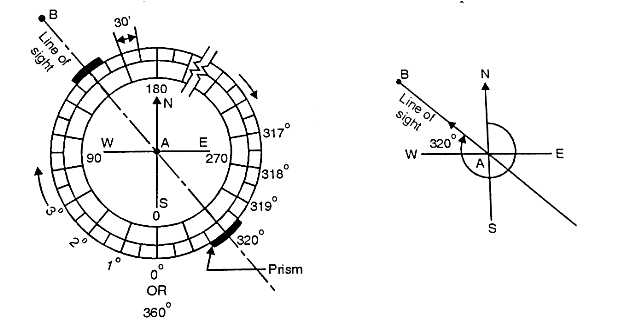
Fig.1.2: Graduations in Prismatic Compass
Key Takeaways:
1) Prismatic compass is used for angular measurements of angles between two or more relative points in horizontal plane. The prismatic compass is a portable form of magnetic compass which is installed on a tripod stand by which angles are measured in horizontal plane.
The horizontal angle made by a survey line with reference to magnetic north pole in a clockwise direction is called as the bearing of a line.
Types of bearings:
Generally, the bearings of survey lines are designated in the following two types:
1. Whole circle bearing (W.C.B.) system:
a) When the bearing of a line is measured with respect to magnetic north in clockwise direction, it is called as magnetic bearing or whole circle bearing.
b) The value of W.C.B. varies from 0° to 360°.
c) Four quadrants I, II, III and IV are shown in Fig.
d) The W.C.B. of a line OA in the first quadrant is  (
( between 0° to 90°).
between 0° to 90°).
e) The W.C.B. of a line OB in the second quadrant with respect to north is  (
( between 90° and 180°) W.C.B. of a line OC in the third quadrant with respect to north is
between 90° and 180°) W.C.B. of a line OC in the third quadrant with respect to north is (
( between 180° and 270°) and W.C.B. of a line OD in the fourth quadrant with respect to north is
between 180° and 270°) and W.C.B. of a line OD in the fourth quadrant with respect to north is  , (
, ( between 270° and 360°).
between 270° and 360°).
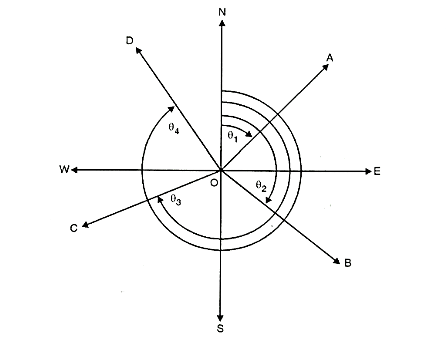
Fig.1.3: Whole Circle bearing
2. Reduced bearing (Quadrantal system):
a) In reduced bearing, the bearing of survey lines is measured with respect to north and south line either in clockwise or anticlockwise direction towards east or west.
b) Fig. shows quadrantal bearing system.
c) Any line in any of the four quadrant is expressed by an angle which is measured from either north or south.
d) The directions are essentially written before and after the value of angle.
e) This helps to identify in which quadrant the lines lie. The maximum bearing in such case is 90°.
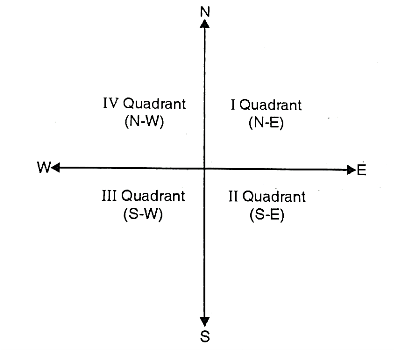
Fig.1.4: Quadrantal bearing
Key Takeaways:
1) Generally, the bearings of survey lines are designated in the following two types:
1) Whole circle bearing (W.C.B.) system.
2) Reduced bearing (Quadrantal) system.
The reference line with respect to which horizontal angle of survey line is measured, known as meridian.
Types of meridians:
a) True Meridian: The line or length passing through the geometrical north pole, geographical south pole and any point on the earth surface is known as true meridian.
b) Magnetic Meridian: It is the direction indicated by freely suspended and balanced magnetic needle unaffected by local attractive forces. The location of magnetic pole is continuously changes hence, the direction of magnetic also changes.
c) Arbitrary Meridian: It is any convenient direction usually from survey station to some well-defined permanent object. This is used for small area survey or to determine the relative direction of small traverse.
Key Takeaways:
1) There are three types of meridian:
a) True meridian.
b) Magnetic meridian.
c) Arbitrary meridian.
1) When the suspended magnetic needle will point towards the north direction (magnetic meridian);
2) But if the compass is centered nearby iron or steel structure or electric cable line such as LT. line or transmission tower, lamp post carrying high voltage, steel button of shirt or freely steel wrist watch, bunch of keys, steel tape etc.
3) Then it is observed that the magnetic needle of prismatic compass will not point exactly towards north but will deflect from its normal position.
4) In short, the magnetic needle is under the influence of some external forces causing the deflection of needle from its normal position and showing some error in bearings of lines.
5) Therefore, it is concluded that the deviation of the magnetic needle from its normal position (North direction) under the influence of external forces is called as local attraction.
6) Local attraction shows some error in bearings of lines, therefore while selecting the stations for compass survey, objects made up of steel shall possibly be avoided.
Detection of Local Attraction:
1) The presence of local attraction can be detected or identified by observing the difference between the observed fore bearing (F.B.) and back bearings (B.B.) of each line.
2) If the difference between F.B. and B.B. is not exactly 180°, then the stations on the both sides of a line are affected by local attraction.
3) If the difference between F.B. and B.B. is exactly 180°, then the stations on both the sides of a line are free from local attraction, or the amount of local attraction at both stations is same.
Note: If F.B.-B.B. = 180°; free from local attraction / same local attraction.
If F.B.-B.B. 180°; affected by local attraction.
Effect on included angle:
a) After plotting the close traverse from observed F.B. and B.B. readings, total sum of the internal included angles of the traverse is not equal to the correct sum of the internal included angles of that traverse [i.e. (2n 4) x 90° where n number of sides of traverse] due to error caused by local attraction.
b) In short, an included angle is not correct on measurement due to local attraction and some adjustment is required to be done to compensate the error.
Adjustment of Local Attraction or Eliminating the Effect of Local Attraction:
There are two methods by which the effect of local attraction can be eliminated or can be adjusted.
Method I:
a) In this method, the difference in fore bearings (F.B.) and back bearings (B.B.) of all the survey lines of the traverse are observed.
b) If for the line, difference between F.B. and B.B. is exactly equal to 180°, then this line is selected and the process of applying correction is started from bearings of this line itself and then corrections are applied to the observed bearings of other lines.
c) It is noted that, if the observed bearing is less than the corrected bearing, the error is negative and correction applied to the bearing is positive.
d) If the observed bearing is more than the corrected bearing the error is positive and correction applied to the bearing is negative.
Method II:
a) In this method, the included angles between the lines are calculated at all the stations. If the traverse is of closed type, the sum of the internal included angles must be equal to (2n-4) x 90° where n is number of sides of the closed traverse.
b) If there is any discrepancy in the total of the included angles, then discrepancy or error is distributed equally to all the angles.
c) When all the angles are corrected then, difference between F.B. and B.B. of each line is found to be 180°.
d) This method is based on the fact that the included angles calculated from incorrect bearings will be correct, since the amount of error is same for all the bearings at the station.
Key Takeaways:
1) The deviation of the magnetic needle from its normal position (North direction) under the influence of external forces is called as local attraction.
1) The horizontal balanced position of the magnetic needle gets disturbed due to the magnetic influence of the earth. The needle dips on one of its sides towards the pole. The angle which the deflected needled makes with horizontal is known as dip of the magnetic needle.
2) The needle is brought to its horizontal position by attaching a small weight called rider to the higher side of the magnetized needle.
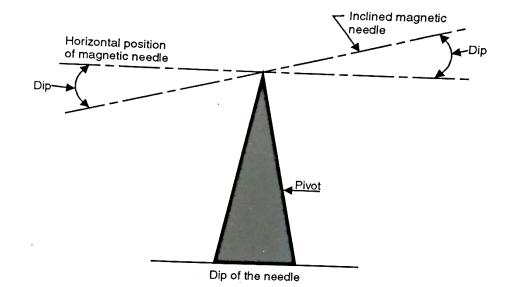
Fig.1.5: Dip of the needle
Key Takeaways:
1) The angle which the deflected needled makes with horizontal is known as dip of the magnetic needle.
1) The magnetic meridian and true meridian are same only at few places, whereas at other places they do not coincide. The horizontal angle between the true meridian and magnetic meridian at a place is known as 'magnetic declination".
2) The magnetic meridian may fall on either east or west of true meridian and accordingly the declination is said to be 'East' or 'West' as shown in Fig.

Fig.1.6: East and West declination respectively
Determination of Declination:
The methods commonly adopted for determining magnetic declination are:
1. By observation to sun:
a) The bearing of line with respect to true north can be determined by taking observation to the sun and then its magnetic bearing is observed by a prismatic compass. When the true meridian and magnetic meridian of a line is known is declination can be observed by relation.
b) True bearing- magnetic bearing= Declination.
2. By isogenic charts:
a) An 'isogenic line' is a line joining the points having same declination. The line joining points of zero declination is called 'agonic line'. The Govt. publishes these isogenic charts.
Key Takeaways:
1) The horizontal angle between the true meridian and magnetic meridian at a place is known as 'magnetic declination".
Q. A line was drawn to magnetic bearing of 238° 20' on an old map when mag. 5°40’ E. To What bearing it should be set now if present magnetic declination is 3° 10' W
True bearing of line = magnetic bearing  Declination = 288°20'+ 5°40’=244 °
Declination = 288°20'+ 5°40’=244 °
Now, declination is 3°10' W
Bearing = 244°--3°10’=240°50’
Q. The magnetic bearing of sun at noon is 356° 30' Find the declination.
True bearing = mag. bearing ± Declination
360° =356° 30’ Dectination.
Dectination.
Declination = 3°30' E
The accessories of plane table are:
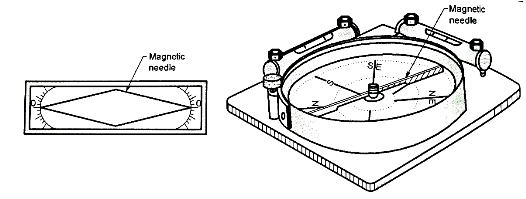
Fig.1.7: Trough and Circular Compass
A trough compass or circular box compass:
a) These compasses are used to mark north direction on the drawing sheet.
A plumbing fork or U frame:
a) It is used for centering the table.
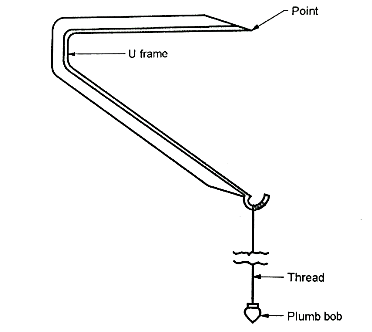
Fig.1.8: Plumb bob with U frame
A bubble tube or spirit level:
a) If bubble tube is not fitted to aliased, the separate bubble tube is used for leveling the table.

Fig.1.9: Spirit level
A water proof cover:
a) It is used to protect the sheet from rain.
Drawing sheet:
a) Drawing sheet should be of best quality.
b) It should be never be folded or rolled but should be carried flat.
c) To reduce the strain on the eyes, the sheet should be of faint colour.
d) Zinc or celluloid sheets are used for plane tabling in damp climates.
e) Sheet should be properly stretched on drawing board with clips or by pasting the edges of sheets.
Other drawing materials:
Other drawing materials required are pins, pencils, rubber, scales etc.
Key Takeaways:
1) The accessories of plane table are:
a) A trough compass or circular box compass.
b) A plumbing fork or U frame.
c) A bubble tube or spirit level.
d) A water proof cover.
e) Drawing sheet.
f) Other drawing materials.
1) It is most suitable for survey of details between stations which have already been fixed by theodolite or any other accurate method of surveying.
2) It is commonly employed for small and medium scale mapping of comparatively large areas where great accuracy is not the main consideration such as for topographical surveys.
Advantages:
Disadvantages:
1) The degree of precision to be attained in plane tabling depends upon the character of the survey, the quality of the instrument, the system adopted and upon the degree to which accuracy is deliberately sacrificed for speed.
2) The various sources of errors may be classified as:
1. Instrumental Errors:
2. Error due to Manipulation and Sighting: These includes-
(a) Non-horizontality of board.
(b) Defective sighting.
(c) Defective orientation.
(d) Movement of board between sights.
(e) Defective or inaccurate centering.
(a) Non-horizontality of board:
(b) Defective Orientation:
(c) Defective Orientation:
(d) Movement of board between sights:
(e) Inaccurate Centering:
Key Takeaways:
1) There are two types of errors:
a) Instrumental Errors.
b) Error due to Manipulation and Sighting.
1.21.1 Radiation:

Fig.1.10: Resection Method
Procedure:
Use:
1.21.2 Intersection method:
In intersection method the point is fixed on plan by the intersection of the rays drawn from the two instrument stations.
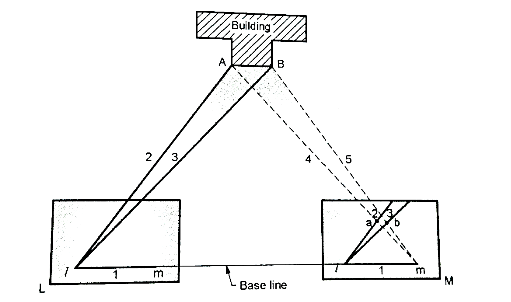
Fig.1.11: Intersection method
Procedure:
Use:
The intersection method is used for:
1.21.3 Traversing Method:
In this method the instrument is shifted from one station to another.

Fig.1.12: Traversing Method
Procedure:
Uses:
Traversing method is used:
1.21.4 Resection Method:
Only the instrumentation stations established by this method.
After fixing the stations, details are located either by radiation or intersection.
Procedure:
Key Takeaways:
2) Methods of plane table surveying are as follows:
a) Radiation Method.
b) Intersection method.
c) Traversing method.
d) Resection method.
1) An art of measuring the relative heights or elevations of the points or objects on the surface of the earth is called as levelling.
2) Levelling deals with the measurements in a vertical plane.
3) It can also be defined as an operation for the measurements in a vertical plane.
1.22.1 Types of leveling:
Types of leveling are as follows:
1. Simple leveling:
When the difference of leveling between two points is determined by setting the leveling instrument midway between the points, the process is called as simple leveling.
2. Differential leveling:
It is adopted when-
This method is also called as compound leveling. In this method the level is set up at several suitable position and staff reading are taken at all of these.
3. Fly leveling:
When the differential leveling is done in order to connect a benchmark to the starting point of alignment of any project then it is called Fly levelling.
4. Profile leveling:
The operation of taking level along the centerline of any alignment at regular interval is called as profile leveling.
5. Cross-section leveling:
The operation taking transverse to the direction of longitudinal or profile leveling is known as cross section leveling.
Key Takeaways:
1) There are five types of leveling:
a) Simple leveling.
b) Differential leveling.
c) Fly leveling.
d) Profile leveling.
e) Cross-section leveling.
Types of Benchmark area as follows:
1. G.T.S. bench marks (Great trigonometrical survey bench marks):
a) These bench marks are established by the survey of India department throughout the country with very high precision with reference to mean sea level (m.s.l.) considered as zero level at Karachi in Pakistan.
b) The positions of G.T.S. bench marks and elevations are shown on the G.T.S. maps published by survey of India department.
c) Levelling work carried out with reference to G.T.S. bench marks give elevations of points with respect mean sea level.
2. Permanent bench marks:
a) These are permanent reference points established with reference to G.T.S. benchmarks on permanent objects like bridge parapets, culverts, well, plinth of any government buildings.
b) The location and reduced level of this bench mark is usually marked on top of the permanent object.
3. Arbitrary bench marks:
a) When small ordinary levelling work is to be carried out or when permanent bench marks are not nearby the place where survey is to be carried out, then to start the levelling work any prominent object like plinth or steps of the building etc. is chosen as bench mark and its elevation is assumed arbitrarily.
b) The elevation of points obtained in this type of levelling work are elevations with respect to the arbitrary bench mark and not with respect to mean sea level as the elevation of B.M. is assumed arbitrarily.
4. Temporary bench marks:
a) The survey for big projects normally continues for a number of days. Hence at the end of the day, when the levelling work for that day has to be stopped, then any permanent object is chosen on which the work is stopped and can be started further on the next day. Then these types of bench marks chosen are known as temporary bench marks.
b) With reference to this temporary bench mark, the work is carried forward on the next day and so on.
Key Takeaways:
1) There are four types of benchmarks:
a) G.T.S. bench marks (Great trigonometrical survey bench marks).
b) Permanent bench marks.
c) Arbitrary bench marks.
d) Temporary bench marks.
1) The dumpy level is commonly used for levelling work being compact and stable type instrument. Fig. shows a dumpy level.
2) The purpose of dumpy level is to provide a horizontal line of sight after the adjustments are done.
3) The dumpy level consists of the following parts:
a) A tripod stand.
b) Levelling Head.
c) Telescope.
(a) A tripod stand:
1) A tripod stand as shown in Fig. is used to support the dumpy level.
2) Before starting the levelling work, the dumpy level is mounted on the tripod and is fixed.
(b) Levelling head:
1) The levelling head levels the dumpy level instrument by bringing the bubble in its center of its run.
2) It consists of two parallel plates with minimum three-foot screws which bring the instrument in a proper level.
(c) Telescope:
1) In the dumpy level, a telescope is rigidly fixed to its supports and a bubble tube is placed parallel on top of telescope as shown in Fig.
2) The telescope consists of a movable eyepiece on one side and an object glass on the other side.
3) A diaphragm consisting of a circular glass with cross wires is fitted just in front of the eyepiece. Fig. shows a pattern of the diaphragm fitted just in front of eyepiece of dumpy level.
4) The eyepiece can be rotated either clockwise or anti-clockwise to make the cross wires of diaphragm clear and distinct.
5) A focusing screw is provided on the telescope to make the images of the object look clear and distinct and to bring the image in the plane of the cross-hairs of the the objective side to protect the object glass from diaphragm.
6) A ray shade is provided on the objective side to protect the object glass from direct rays of the sun.
7) Sometimes, a provision of a compass on the lower side of telescope is made for observing bearing of a line.
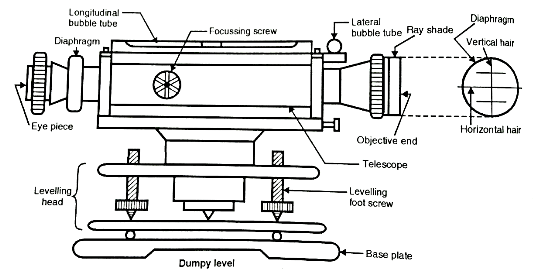
Fig.1.14: Dumpy level
Key Takeaways:
1) The dumpy level is commonly used for levelling work being compact and stable type instrument.
1) These instruments require only approximate levelling by reference to a good circular bubble, and they have no sensitive bubble.
2) The path of the line of sight through the telescope includes reflection at mirrors or prisms which are suspended on fine threads or on a component hanging as a pendulum and the mechanical design of the suspended portion is such that if the body of the instrument is slightly disturbed the consequent motion of the suspended component resets the line of sight into the former direction.
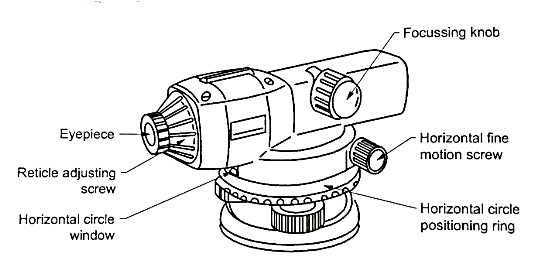
Fig.1.15: Auto level
Setting up the Instrument:

Fig.1.16: Auto level
Focusing and Sighting:
Operation:
Measuring height difference:
1) Set up the instrument at a point approximately halfway between points A and B.
2) For more accurate measurement, set the instrument as close to halfway as possible, to eliminate errors due to sighting axis misalignment.
3) Position the staff vertically at point A and take the reading a (backsight) on the staff at point A.
4) Then sight the staff at point B and obtain the reading b(foresight).

Fig.1.17: Set up
5) The difference a - b is the height difference h of B from A. Example: h = a - b = 1.735 m- 1.244 m = 0.511 m
6) <When the distance between points A and B is large or if the height difference is great>
7) Divide the distance into a number of sections and determine the height difference of each section. The height difference between points A and B is the total of the height differences of all the sections using the following formula.
8) Altitude of the required point altitude of known point+ total of backsight values total of foresight values.
9) This simple leveling technique has no error check. It is better to measure from A to B and back to A so that the error of closure can be calculated.
Measuring Horizontal Angle:
1) The horizontal circle graduations are annotated in a clockwise direction. As a result, sighting is performed from left to right.
2) Set up the instrument directly above the surveying point.
3) Sight point A, and set the horizontal circle to 0° by turning the horizontal circle positioning ring.
4) Sight point B and take the angle reading.
Key Takeaways:
1) These instruments require only approximate levelling by reference to a good circular bubble, and they have no sensitive bubble.
1) It is an automatic level consisting of pendulum compensator. It is capable for normal optical levelling with a rod graduated in meter or feet. Digital level has a provision to take readings automatically by using a bar code.
2) Digital level and bar code is as shown in Fig. It is an automatic level consisting of pendulum compensator. It is capable for normal optical levelling with a rod graduated in meter or feet. Digital level has a provision to take readings automatically by using a bar code.
3) Digital level and bar code is as shown in Fig.
4) It has digital and electronic image processing features which can be used to determine the heights and distances with the automatic recording of data which can further be transferred to computer database.
5) Length of the rod is 4.05 m and this rod is graduated in bar code on one side or on the both sides as shown in fig.
6) After capturing and processing the image of the bar code rod, this processed image of the rod reading is then compared with the image of the complete rod which is permanently stored in memory module of level so as to determine elevation i.e., height and distances.
Procedure:
Key Takeaways:
1) It is an automatic level consisting of pendulum compensator. It is capable for normal optical levelling with a rod graduated in meter or feet. Digital level has a provision to take readings automatically by using a bar code.
1) It is advanced type of instrument used in surveying work. It consists of a revolving laser beam to ensure precise horizontal level detection and dramatically improve the efficiency of levelling jobs on civil engineering and construction sites.
2) The main unit automatically emits a continuous laser beam that sweeps a full rotation of 360° so as to allow the operator to mark any location with loom radius.
3) Laser level is highly accurate instrument and very easy to use and operate and imparts the maximum efficiency while taking readings. With the help of laser level system, a single operator can perform even the most complicated levelling tasks.
4) The set up the main unit, just use the built-in circular spirit level to set the unit within 10' of horizontal. The automatic compensation mechanism makes sure the beam plane is perfectly level and ready for use. Its rugged, lightweight design and easy operation make it perfect for any kind of engineering, construction or interior application.
5) The beam detector gives the relative position of the beam with an easy-to-read display and audible tones for quick, precise marking.
6) Laser level instrument is waterproof and hence all the important components are protected from wet weather. Laser level imparts high precision, easy operation and proven durability in a single, compact package
7) Sokkia LP3A and Leica Javelin series lasers are the manufacturers of laser level. Sokkia LP3A level laser and Javelin laser level are available in market.
8) This type of laser instrument is used for fine grading, rough grading general construction work, excavation, land levelling steep slopes and land-fills.
Key Takeaways:
1) Lazer level is advanced type of instrument used in surveying work. It consists of a revolving laser beam to ensure precise horizontal level detection and dramatically improve the efficiency of levelling jobs on civil engineering and construction sites.
Line of collimation:
1) It is the line joining the intersection of the cross-hairs of the diaphragm optical center of the object glass and its continuation further.
2) Line of collimation is also called the line of sight.
Axis of telescope:
1) It is the line joining the optical center of eyepiece and object glass.
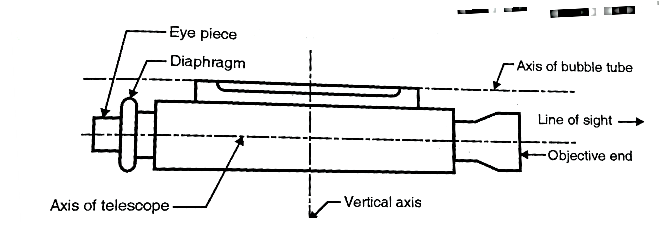
Fig.1.18: Axes of Dumpy level
Axis of the level tube:
1) It is an imaginary line which is tangential to the longitudinal curvature of the bubble tube at its center.
2) Axis of the level tube is also called the bubble tube axis.
Vertical axis:
1) It is the axis about which the telescope can be rotated in a horizontal plane.
Key Takeaways:
1) There are four types of principle axis:
a) Line of collimation.
b) Axis of telescope.
c) Axis of level tube.
d) Vertical axis.
There are following permenant adjustments:
1) When it is necessary to carry levelling across a river or any obstacle a long sight between two points so situated that no place for the level can be found from which the lengths of foresight and backsight will be even approximately equal. Special method i.e., reciprocal levelling must be used to obtain accuracy and to eliminate the following errors due to-

Fig.1.19; Set up
Reciprocal levelling involves:
1) In precise levelling work or when the sights are long, the effects of curvature and refraction have to be taken into account.
2) It is evident that a horizontal line departs from a level surface because of the curvature of earth.
3) And in the long sights, the horizontal line of sight does not remain straight but it slightly bends downwards having concavity towards earth surface due to refraction.
4) The effect of curvature is to cause the objects sighted to appear lower than they really are.
5) While that of refraction is to make them appear higher than they really are.
6) The combined effect of curvature and refraction is such that objects appear lower than they really are.
Curvature:
1) The vertical distance between the horizontal line and the level line represents the effect of the curvature of the earth.
2) the correction for curvature in meter = 0.0785 d
where, d is the distance in km from the level to the staff station.
3) True staff reading may, therefore, be obtained by subtracting the correction for curvature from the observed staff reading
True staff reading = observed staff reading -0.0785 d²
Refraction:
1) The effect of refraction is the same as if the line sight was curved downwards or concave towards the earth's surface and hence the rod reading is decreased.
2) The correction of refraction, C, is 0.01122d2 meters
where d is taken in km.
Key Takeaways:
1) In precise levelling work or when the sights are long, the effects of curvature and refraction have to be taken into account. It is evident that a horizontal line departs from a level surface because of the curvature of earth.
1) Let 'C' be the point of observation its height being equal to 'h'
2) Let 'A' be the point on the horizon i.e., a point where the tangent from P meets the level line.
3) If dv, is the distance to visible horizon it is given by dv, Km
Km
d = 3.853 √C km.
C being in meters.
In this method, the reduced level of collimation plane or height of instrument is determined for each set up of dumpy level and then reduced levels (R.L.) of the other points are found out with respect to the plane of collimation or height of instrument.
Level page of the field book
Staff Station | B.S | I.S | F.S | H.I (Collimation plane level) | R.L | Remarks |
B.M |
|
|
|
|
|
|
1 |
|
|
|
|
|
|
2 |
|
|
|
|
|
|
3 |
|
|
|
|
|
|
Procedure:
1) Step 1: To prepare the format of level page before levelling work start:
For entering the readings of reduced level of different sights, the following format of level page is commonly used into practice.
2) Step 2: To find the height of instrument (H.I.) or R.L. of plane of collimation:
Keep the levelling staff on bench mark (B.M.) and take reading and find the reduced level of collimation plane or height of instrument by adding back sight reading to the R.L. of bench mark.
Note that, Height of instrument is equal to R.L. of collimation plane.
Height of instrument (H.I.) = R.L. of bench mark + B.S. reading.
3) Step 3: To find R.L. of intermediate points or change points:
Reduced level of intermediate points can be found out as follows:
R.L. of intermediate points =Height of instrument - Intermediate sight reading
=H.I-.I.S. reading
R.L. of change point =Height of instrument - Fore sight reading
= H.I. - F.S. reading
Note: When levelling work is to be stopped or change point is to be taken, then foresight reading is taken.
4) Step 4: To find new height of instrument or new plane of collimation:
The instrument is shifted and set up and levelled at new position so that reading on levelling staff would be clear and distinct. Then take back sight reading on change point (C.P.) and find the R.L. of new collimation plane or new height of instrument. Refer to Fig.
R.L. of new height of instrument =R.L. of change point + B.S.
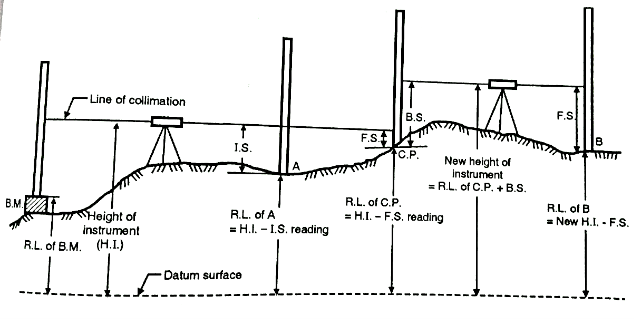
Fig.1.20: H.I Reading method
5) Step 5: To find reduced levels of the remaining points:
Find the reduced levels of the remaining points from new set up of instrument with respect to new height of instrument or new R.L. of collimation plane.
6) Step 6: To finish the levelling work:
Repeat the above procedure till all the levelling work is over.
7) Step 7: To find arithmetical check:
After completion of levelling work, arithmetical check is found out. From this check. accuracy of the field work of levelling can be cross-checked. This check can be taken at each level page.
8) Arithmetical check:
Sum of backsights - sum of foresights =Last R.L. - First R.L.
In short,  . -
. -  .= Last R.L. - First R.L.
.= Last R.L. - First R.L.
9) Note: It is noted that the arithmetical check can be taken at each level page.
1) In this method, instead of H.I. column in the format of level page, two columns of rise and fall are introduced for calculation of R. L’s. Difference of levels between consecutive points is found by comparing the staff readings on the two points for the same setting the instrument.
Rise and fall method is stepwise explained as follows:
1) Step 1: Prepare the format of level page before levelling work start, as shown below:
Level Page of field book
Staff Station | B. S | I.S | F. S | Rise | Fall | R. L | Remark |
B.M |
|
|
|
|
|
|
|
A |
|
|
|
|
|
|
|
B |
|
|
|
|
|
|
|
C |
|
|
|
|
|
|
|
. |
|
|
|
|
|
|
|
. |
|
|
|
|
|
|
|
2) Step 2: The difference in staff readings between the consecutive points is found out.
3) Step 3:
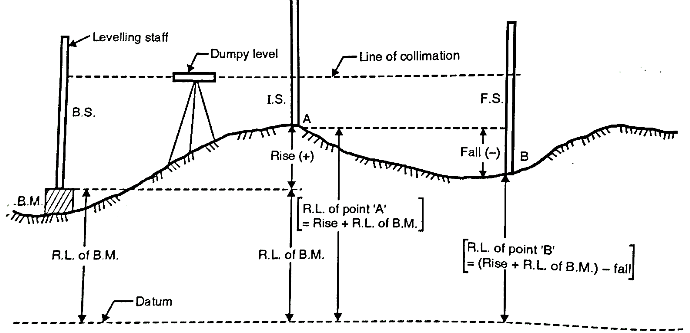
Fig.1.21: Rise and fall method
4) Step 4: Repeat the same procedure till the levelling work is over.
5) Step 5: After completion of levelling work, the arithmetical check is found out, which shows accuracy and cross check of the field work in levelling. Note that, the check can be taken at each level page and on R.L., of every intermediate points.
6) Arithmetical check:
Sum of backsights - sum of foresights = Sum of all rise- sum of all= Last R.L. - First R.L.
In short, Σ B.S. -  . = Rise-fall=Last R.L – First R.L
. = Rise-fall=Last R.L – First R.L
7) Note: It is noted that arithmetical check can be taken on R.L. of intermediate points.
8) In this method calculation work is more, therefore it is tedious but there is check on every point; hence it is accurate method rather than H.I. method.
References: